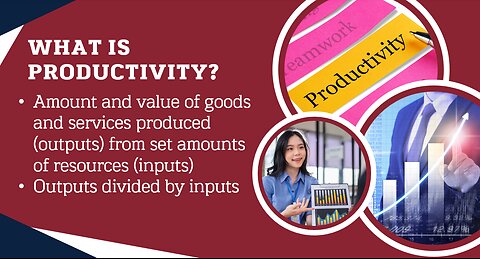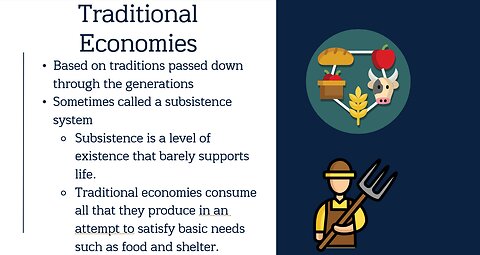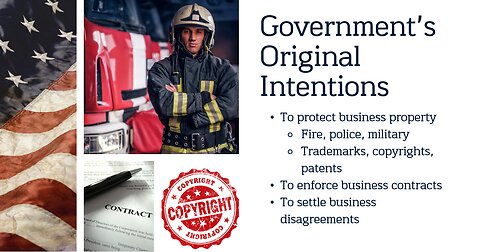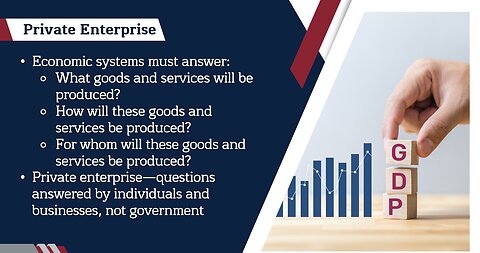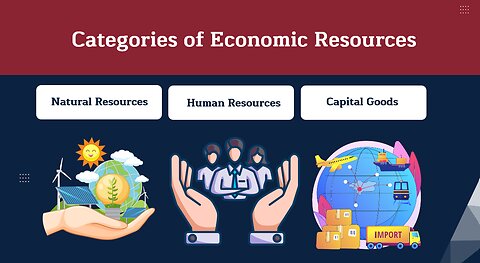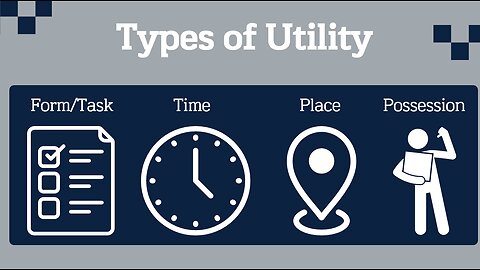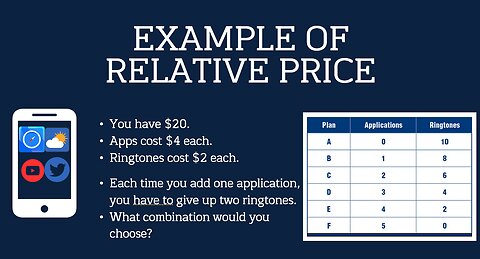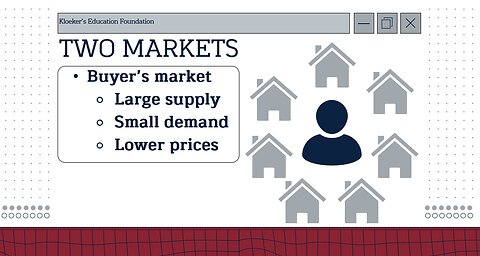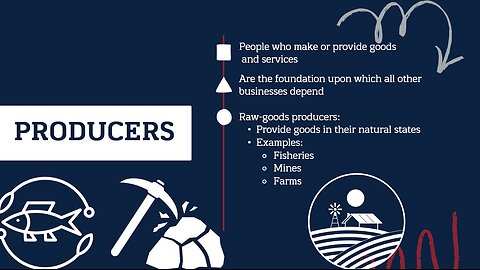
Intro to Business Course
17 videos
Updated 6 months ago
-
Intro to Business: Business & Society Lesson
 KloekersEducationFoundation🎓 Intro to Business: Business & Society | Full Lecture Video (Unit 17) Welcome to Kloeker’s Education Foundation, where we provide quality content for amazing teachers. In this final unit video, we explore how business operates within—and contributes to—society. From producers and trade industries to community service and social responsibility, this lesson wraps up the course with real-world relevance and ethical reflection. 🧠 What You’ll Learn in This Lesson: The three major types of business operations in the economy: • Producers – raw-goods providers, manufacturers, and builders • Trade industries – retailers and wholesalers • Service businesses – healthcare, education, transportation, finance, and more How businesses differ by: • Size, location, service level, ownership, and variety of products • Retailing methods: in-person, online, mail, vending, etc. The concept of social responsibility: • Profit-making with a purpose • Environmental sustainability • Community partnerships and contributions • Product safety, employee well-being, and local support Real examples from major corporations The Gray Zone: Should a company’s owners have full control over public contributions, or should employees have a say? 📥 Companion materials available: PowerPoint, lecture notes, handouts, vocabulary, activities, and assessments can be found in the 👉 Intro to Business: Business & Society Unit 17 Bundle on TeachersPayTeachers 🔗 Link to PowerPoint: https://www.teacherspayteachers.com/Product/Intro-to-Business-Business-Society-PowerPoint-13720689 🔗 Link to Unit: https://www.teacherspayteachers.com/Product/Intro-to-Business-Business-Society-Unit-17-Bundle-13720713 🔗 Link to Store: https://www.teacherspayteachers.com/store/kloekers-education-foundation 📌 Ideal for high school business or CTE students, this lecture aligns with TEKS and national business education standards. 👍 Like this video to support the channel 🔔 Subscribe for more high-quality business, government, and history lessons 💬 Comment below with classroom ideas or questions! #BusinessAndSociety #IntroToBusiness #SocialResponsibility #BusinessEducation #CTE #KloekerEducationFoundation #TeachersPayTeachers #EthicsInBusiness #HighSchoolBusiness5 views
KloekersEducationFoundation🎓 Intro to Business: Business & Society | Full Lecture Video (Unit 17) Welcome to Kloeker’s Education Foundation, where we provide quality content for amazing teachers. In this final unit video, we explore how business operates within—and contributes to—society. From producers and trade industries to community service and social responsibility, this lesson wraps up the course with real-world relevance and ethical reflection. 🧠 What You’ll Learn in This Lesson: The three major types of business operations in the economy: • Producers – raw-goods providers, manufacturers, and builders • Trade industries – retailers and wholesalers • Service businesses – healthcare, education, transportation, finance, and more How businesses differ by: • Size, location, service level, ownership, and variety of products • Retailing methods: in-person, online, mail, vending, etc. The concept of social responsibility: • Profit-making with a purpose • Environmental sustainability • Community partnerships and contributions • Product safety, employee well-being, and local support Real examples from major corporations The Gray Zone: Should a company’s owners have full control over public contributions, or should employees have a say? 📥 Companion materials available: PowerPoint, lecture notes, handouts, vocabulary, activities, and assessments can be found in the 👉 Intro to Business: Business & Society Unit 17 Bundle on TeachersPayTeachers 🔗 Link to PowerPoint: https://www.teacherspayteachers.com/Product/Intro-to-Business-Business-Society-PowerPoint-13720689 🔗 Link to Unit: https://www.teacherspayteachers.com/Product/Intro-to-Business-Business-Society-Unit-17-Bundle-13720713 🔗 Link to Store: https://www.teacherspayteachers.com/store/kloekers-education-foundation 📌 Ideal for high school business or CTE students, this lecture aligns with TEKS and national business education standards. 👍 Like this video to support the channel 🔔 Subscribe for more high-quality business, government, and history lessons 💬 Comment below with classroom ideas or questions! #BusinessAndSociety #IntroToBusiness #SocialResponsibility #BusinessEducation #CTE #KloekerEducationFoundation #TeachersPayTeachers #EthicsInBusiness #HighSchoolBusiness5 views -
Intro to Business: Business Activities Lesson
 KloekersEducationFoundation🎓 Intro to Business: Business Activities | Full Lecture Video (Unit 16) Welcome to Kloeker’s Education Foundation, where we provide quality content for amazing teachers. In this video, we break down the six core functions that every business must perform—from managing finances to leading a team—and explain how these roles work together to keep a company running smoothly. 🧠 What You’ll Learn in This Lesson: What defines a business (for-profit vs. nonprofit) The six primary business activities every organization must manage: • Financial Analysis – Budgeting, loans, and tracking costs • Human Resources Management – Hiring, training, and leading employees • Information Management – Organizing and securing business data • Marketing – Product, price, promotion, and place strategies • Operations – Inventory, scheduling, and quality control • Strategic Management – Setting goals and long-term planning How businesses adjust when one area changes (e.g., budget cuts, staff shortages) Real-world examples: business mergers, outsourcing, and digital transformation The Gray Zone: Should companies move their operations overseas to save money— even if it affects local jobs? 📥 Companion materials available: PowerPoint, lecture notes, handouts, activities, and assessments can be found in the 👉 Intro to Business: Business Activities Unit 16 Bundle on TeachersPayTeachers 🔗 Link to PowerPoint: https://www.teacherspayteachers.com/Product/Intro-to-Business-Business-Activities-PowerPoint-13720493 🔗 Link to Unit: https://www.teacherspayteachers.com/Product/Intro-to-Business-Business-Activities-Unit-16-Bundle-13720524 🔗 Link to Store: https://www.teacherspayteachers.com/store/kloekers-education-foundation 📌 Ideal for high school business or CTE students, this lecture aligns with TEKS and national business education standards. 👍 Like this video to support the channel 🔔 Subscribe for more high-quality business, government, and history lessons 💬 Comment below with classroom ideas or questions! #BusinessActivities #IntroToBusiness #CTE #HighSchoolBusiness #KloekerEducationFoundation #BusinessFunctions #TeachersPayTeachers #BusinessEducation7 views
KloekersEducationFoundation🎓 Intro to Business: Business Activities | Full Lecture Video (Unit 16) Welcome to Kloeker’s Education Foundation, where we provide quality content for amazing teachers. In this video, we break down the six core functions that every business must perform—from managing finances to leading a team—and explain how these roles work together to keep a company running smoothly. 🧠 What You’ll Learn in This Lesson: What defines a business (for-profit vs. nonprofit) The six primary business activities every organization must manage: • Financial Analysis – Budgeting, loans, and tracking costs • Human Resources Management – Hiring, training, and leading employees • Information Management – Organizing and securing business data • Marketing – Product, price, promotion, and place strategies • Operations – Inventory, scheduling, and quality control • Strategic Management – Setting goals and long-term planning How businesses adjust when one area changes (e.g., budget cuts, staff shortages) Real-world examples: business mergers, outsourcing, and digital transformation The Gray Zone: Should companies move their operations overseas to save money— even if it affects local jobs? 📥 Companion materials available: PowerPoint, lecture notes, handouts, activities, and assessments can be found in the 👉 Intro to Business: Business Activities Unit 16 Bundle on TeachersPayTeachers 🔗 Link to PowerPoint: https://www.teacherspayteachers.com/Product/Intro-to-Business-Business-Activities-PowerPoint-13720493 🔗 Link to Unit: https://www.teacherspayteachers.com/Product/Intro-to-Business-Business-Activities-Unit-16-Bundle-13720524 🔗 Link to Store: https://www.teacherspayteachers.com/store/kloekers-education-foundation 📌 Ideal for high school business or CTE students, this lecture aligns with TEKS and national business education standards. 👍 Like this video to support the channel 🔔 Subscribe for more high-quality business, government, and history lessons 💬 Comment below with classroom ideas or questions! #BusinessActivities #IntroToBusiness #CTE #HighSchoolBusiness #KloekerEducationFoundation #BusinessFunctions #TeachersPayTeachers #BusinessEducation7 views -
Intro to Business: Productivity Lesson
 KloekersEducationFoundation🎓 Intro to Business: Productivity | Full Lecture Video (Unit 15) Welcome to Kloeker’s Education Foundation, where we provide quality content for amazing teachers. In this video, we explore how productivity impacts businesses, workers, consumers, and the entire economy—plus how it can be measured and improved in the real world. 🧠 What You’ll Learn in This Lesson: What productivity is and how to calculate it using the formula: • Productivity = Outputs ÷ Inputs Examples of productivity in both goods-producing and service-based industries Why productivity matters: • For businesses: cost control and profit • For workers: job security and higher wages • For consumers: price and product variety • For the economy: growth, employment, and quality of life Common barriers to productivity, including: • Lack of training, planning, tools, or motivation Proven strategies to increase productivity: • Specialization, division of labor, capital investment, mass production, and more The role of communication, education, and employee motivation The Gray Zone: Should companies offer unlimited paid time off? Explore both sides of this real-world workplace debate. 📥 Companion materials available: PowerPoint, lecture notes, handouts, activities, and assessments can be found in the 👉 Intro to Business: Productivity Unit 15 Bundle on TeachersPayTeachers 🔗 Link to PowerPoint: https://www.teacherspayteachers.com/Product/Intro-to-Business-Productivity-PowerPoint-13719497 🔗 Link to Unit: https://www.teacherspayteachers.com/Product/Intro-to-Business-Productivity-Unit-15-Bundle-13719546 🔗 Link to Store: https://www.teacherspayteachers.com/store/kloekers-education-foundation 📌 Ideal for high school business or CTE students, this lecture aligns with TEKS and national business education standards. 👍 Like this video to support the channel 🔔 Subscribe for more high-quality business, government, and history lessons 💬 Comment below with classroom ideas or questions! #Productivity #BusinessEducation #CTE #HighSchoolBusiness #IntroToBusiness #Efficiency #KloekerEducationFoundation #TeachersPayTeachers4 views
KloekersEducationFoundation🎓 Intro to Business: Productivity | Full Lecture Video (Unit 15) Welcome to Kloeker’s Education Foundation, where we provide quality content for amazing teachers. In this video, we explore how productivity impacts businesses, workers, consumers, and the entire economy—plus how it can be measured and improved in the real world. 🧠 What You’ll Learn in This Lesson: What productivity is and how to calculate it using the formula: • Productivity = Outputs ÷ Inputs Examples of productivity in both goods-producing and service-based industries Why productivity matters: • For businesses: cost control and profit • For workers: job security and higher wages • For consumers: price and product variety • For the economy: growth, employment, and quality of life Common barriers to productivity, including: • Lack of training, planning, tools, or motivation Proven strategies to increase productivity: • Specialization, division of labor, capital investment, mass production, and more The role of communication, education, and employee motivation The Gray Zone: Should companies offer unlimited paid time off? Explore both sides of this real-world workplace debate. 📥 Companion materials available: PowerPoint, lecture notes, handouts, activities, and assessments can be found in the 👉 Intro to Business: Productivity Unit 15 Bundle on TeachersPayTeachers 🔗 Link to PowerPoint: https://www.teacherspayteachers.com/Product/Intro-to-Business-Productivity-PowerPoint-13719497 🔗 Link to Unit: https://www.teacherspayteachers.com/Product/Intro-to-Business-Productivity-Unit-15-Bundle-13719546 🔗 Link to Store: https://www.teacherspayteachers.com/store/kloekers-education-foundation 📌 Ideal for high school business or CTE students, this lecture aligns with TEKS and national business education standards. 👍 Like this video to support the channel 🔔 Subscribe for more high-quality business, government, and history lessons 💬 Comment below with classroom ideas or questions! #Productivity #BusinessEducation #CTE #HighSchoolBusiness #IntroToBusiness #Efficiency #KloekerEducationFoundation #TeachersPayTeachers4 views -
Intro to Business: Economic Systems Lesson
 KloekersEducationFoundation🎓 Intro to Business: Economic Systems | Full Lecture Video (Unit 14) Welcome to Kloeker’s Education Foundation, where we provide quality content for amazing teachers. In this video, we explore the four major types of economic systems—traditional, command (communist and socialist), and market—and how each system answers the three fundamental economic questions. 🧠 What You’ll Learn in This Lesson: What an economic system is and why every country must have one Key elements shared by all economies: markets, participants, resources, and exchange Deep dive into the 4 systems: • Traditional – Rooted in customs, with no surplus or innovation • Communist Command – Full government control over production and distribution • Socialist Command – Shared ownership with higher taxes and public services • Market – Individual freedom, private ownership, and profit motive How each system answers: • What to produce? • How to produce? • Who gets the products? Strengths and weaknesses of each system: fairness, innovation, efficiency, and control Real-world examples: Cuba, Sweden, the U.S., North Korea, Amazonian tribes Gray Zone ethical reflection: Should modern governments influence or replace traditional economic cultures? 📥 Companion materials available: PowerPoint, teacher lecture notes, activities, handouts, and assessments can be found in the 👉 Intro to Business: Economic Systems Unit 14 Bundle on TeachersPayTeachers 🔗 Link to PowerPoint: https://www.teacherspayteachers.com/Product/Intro-to-Business-Types-of-Economic-Systems-PowerPoint-13717533 🔗 Link to Unit: https://www.teacherspayteachers.com/Product/Intro-to-Business-Economic-Systems-Unit-14-Bundle-13717575 🔗 Link to Store: https://www.teacherspayteachers.com/store/kloekers-education-foundation 📌 Ideal for high school business or CTE students, this lecture aligns with TEKS and national business education standards. 👍 Like this video to support the channel 🔔 Subscribe for more high-quality business, government, and history lessons 💬 Comment below with classroom ideas or questions! #EconomicSystems #BusinessEducation #IntroToBusiness #CTE #HighSchoolBusiness #KloekerEducationFoundation #MarketEconomy #CommandEconomy #TeachersPayTeachers7 views
KloekersEducationFoundation🎓 Intro to Business: Economic Systems | Full Lecture Video (Unit 14) Welcome to Kloeker’s Education Foundation, where we provide quality content for amazing teachers. In this video, we explore the four major types of economic systems—traditional, command (communist and socialist), and market—and how each system answers the three fundamental economic questions. 🧠 What You’ll Learn in This Lesson: What an economic system is and why every country must have one Key elements shared by all economies: markets, participants, resources, and exchange Deep dive into the 4 systems: • Traditional – Rooted in customs, with no surplus or innovation • Communist Command – Full government control over production and distribution • Socialist Command – Shared ownership with higher taxes and public services • Market – Individual freedom, private ownership, and profit motive How each system answers: • What to produce? • How to produce? • Who gets the products? Strengths and weaknesses of each system: fairness, innovation, efficiency, and control Real-world examples: Cuba, Sweden, the U.S., North Korea, Amazonian tribes Gray Zone ethical reflection: Should modern governments influence or replace traditional economic cultures? 📥 Companion materials available: PowerPoint, teacher lecture notes, activities, handouts, and assessments can be found in the 👉 Intro to Business: Economic Systems Unit 14 Bundle on TeachersPayTeachers 🔗 Link to PowerPoint: https://www.teacherspayteachers.com/Product/Intro-to-Business-Types-of-Economic-Systems-PowerPoint-13717533 🔗 Link to Unit: https://www.teacherspayteachers.com/Product/Intro-to-Business-Economic-Systems-Unit-14-Bundle-13717575 🔗 Link to Store: https://www.teacherspayteachers.com/store/kloekers-education-foundation 📌 Ideal for high school business or CTE students, this lecture aligns with TEKS and national business education standards. 👍 Like this video to support the channel 🔔 Subscribe for more high-quality business, government, and history lessons 💬 Comment below with classroom ideas or questions! #EconomicSystems #BusinessEducation #IntroToBusiness #CTE #HighSchoolBusiness #KloekerEducationFoundation #MarketEconomy #CommandEconomy #TeachersPayTeachers7 views -
Intro to Business: Government & Business Lesson
 KloekersEducationFoundation🎓 Intro to Business: Government & Business | Full Lecture Video (Unit 13) Welcome to Kloeker’s Education Foundation, where we provide quality content for amazing teachers. In this video, we explore the evolving relationship between government and private enterprise in the U.S. economy—how it started, why it expanded, and what it means for businesses today. 🧠 What You’ll Learn in This Lesson: The original role of government in business: protecting property, enforcing contracts, and settling disputes Why government’s role expanded due to: • Industrialization and unfair business practices • Environmental and consumer protection needs • Growth in technology and population The purposes of government involvement, including: • Providing public goods • Improving public welfare and health • Stabilizing the economy (monetary and fiscal policy) • Supporting competition, consumers, and specific industries How government regulates business using: • Laws, licensing, and wage/price controls • Regulatory agencies like the FDA, FCC, OSHA, and FTC The positive and negative effects of regulation Who pays for regulation (hint: taxes and borrowing) Ethical reflection in The Gray Zone: Should neighboring business owners be able to block legal businesses from opening in their district? 📥 Companion materials available: PowerPoint, lecture notes, vocabulary, handouts, group activities, and assessments can be found in the 👉 Intro to Business: Government & Business Unit 13 Bundle on TeachersPayTeachers 🔗 Link to PowerPoint: https://www.teacherspayteachers.com/Product/Intro-to-Business-Government-Business-PowerPoint-13717071 🔗 Link to Unit: https://www.teacherspayteachers.com/Product/Intro-to-Business-Government-Business-Unit-13-Bundle-13717108 🔗 Link to Store: https://www.teacherspayteachers.com/store/kloekers-education-foundation 📌 Ideal for high school business or CTE students, this lecture aligns with TEKS and national business education standards. 👍 Like this video to support the channel 🔔 Subscribe for more high-quality business, government, and history lessons 💬 Comment below with classroom ideas or questions! #GovernmentAndBusiness #EconomicRegulation #HighSchoolBusiness #CTE #IntroToBusiness #BusinessEducation #KloekerEducationFoundation #TeachersPayTeachers #RegulatoryAgencies #FiscalPolicy5 views
KloekersEducationFoundation🎓 Intro to Business: Government & Business | Full Lecture Video (Unit 13) Welcome to Kloeker’s Education Foundation, where we provide quality content for amazing teachers. In this video, we explore the evolving relationship between government and private enterprise in the U.S. economy—how it started, why it expanded, and what it means for businesses today. 🧠 What You’ll Learn in This Lesson: The original role of government in business: protecting property, enforcing contracts, and settling disputes Why government’s role expanded due to: • Industrialization and unfair business practices • Environmental and consumer protection needs • Growth in technology and population The purposes of government involvement, including: • Providing public goods • Improving public welfare and health • Stabilizing the economy (monetary and fiscal policy) • Supporting competition, consumers, and specific industries How government regulates business using: • Laws, licensing, and wage/price controls • Regulatory agencies like the FDA, FCC, OSHA, and FTC The positive and negative effects of regulation Who pays for regulation (hint: taxes and borrowing) Ethical reflection in The Gray Zone: Should neighboring business owners be able to block legal businesses from opening in their district? 📥 Companion materials available: PowerPoint, lecture notes, vocabulary, handouts, group activities, and assessments can be found in the 👉 Intro to Business: Government & Business Unit 13 Bundle on TeachersPayTeachers 🔗 Link to PowerPoint: https://www.teacherspayteachers.com/Product/Intro-to-Business-Government-Business-PowerPoint-13717071 🔗 Link to Unit: https://www.teacherspayteachers.com/Product/Intro-to-Business-Government-Business-Unit-13-Bundle-13717108 🔗 Link to Store: https://www.teacherspayteachers.com/store/kloekers-education-foundation 📌 Ideal for high school business or CTE students, this lecture aligns with TEKS and national business education standards. 👍 Like this video to support the channel 🔔 Subscribe for more high-quality business, government, and history lessons 💬 Comment below with classroom ideas or questions! #GovernmentAndBusiness #EconomicRegulation #HighSchoolBusiness #CTE #IntroToBusiness #BusinessEducation #KloekerEducationFoundation #TeachersPayTeachers #RegulatoryAgencies #FiscalPolicy5 views -
Intro to Business: Private Enterprise System Lesson
 KloekersEducationFoundation🎓 Intro to Business: Private Enterprise System | Full Lecture Video (Unit 12) Welcome to Kloeker’s Education Foundation, where we provide quality content for amazing teachers. In this video, we explore how the U.S. economy works through the lens of private enterprise—including the freedoms, responsibilities, and challenges that come with capitalism. 🧠 What You’ll Learn in This Lesson: What the private enterprise system is and how it functions How the U.S. answers the 3 basic economic questions The six defining features of a capitalist economy: • Freedom in the marketplace • Private property • Limited government control • Competition • Profit motive • Price-directed system Real-world examples of business decisions driven by profit and competition The freedoms private citizens enjoy: choice of career, ownership, entrepreneurship The limitations of those freedoms (e.g., taxes, laws, competition) Challenges of capitalism: poverty, inequality, unemployment, ethics Ethical thinking in The Gray Zone: Should private businesses be required to give back to the community? 📥 Companion materials available: PowerPoint, lecture notes, vocabulary, handouts, group activities, and assessments can be found in the 👉 Intro to Business: Private Enterprise System Unit 12 Bundle on TeachersPayTeachers 🔗Link to PowerPoint: https://www.teacherspayteachers.com/Product/Intro-to-Business-Private-Enterprise-System-PowerPoint-13716605 🔗Link to Unit: https://www.teacherspayteachers.com/Product/Intro-to-Business-Private-Enterprise-System-Unit-12-Bundle-13716670 🔗Link to Store: https://www.teacherspayteachers.com/store/kloekers-education-foundation 📌 Ideal for high school business or CTE students, this lecture aligns with TEKS and national business education standards. 👍 Like this video to support the channel 🔔 Subscribe for more high-quality business, government, and history lessons 💬 Comment below with classroom ideas or questions! #PrivateEnterprise #Capitalism #BusinessEducation #CTE #IntroToBusiness #FreeMarket #HighSchoolEconomics #KloekerEducationFoundation #TeachersPayTeachers #EconomicFreedom8 views
KloekersEducationFoundation🎓 Intro to Business: Private Enterprise System | Full Lecture Video (Unit 12) Welcome to Kloeker’s Education Foundation, where we provide quality content for amazing teachers. In this video, we explore how the U.S. economy works through the lens of private enterprise—including the freedoms, responsibilities, and challenges that come with capitalism. 🧠 What You’ll Learn in This Lesson: What the private enterprise system is and how it functions How the U.S. answers the 3 basic economic questions The six defining features of a capitalist economy: • Freedom in the marketplace • Private property • Limited government control • Competition • Profit motive • Price-directed system Real-world examples of business decisions driven by profit and competition The freedoms private citizens enjoy: choice of career, ownership, entrepreneurship The limitations of those freedoms (e.g., taxes, laws, competition) Challenges of capitalism: poverty, inequality, unemployment, ethics Ethical thinking in The Gray Zone: Should private businesses be required to give back to the community? 📥 Companion materials available: PowerPoint, lecture notes, vocabulary, handouts, group activities, and assessments can be found in the 👉 Intro to Business: Private Enterprise System Unit 12 Bundle on TeachersPayTeachers 🔗Link to PowerPoint: https://www.teacherspayteachers.com/Product/Intro-to-Business-Private-Enterprise-System-PowerPoint-13716605 🔗Link to Unit: https://www.teacherspayteachers.com/Product/Intro-to-Business-Private-Enterprise-System-Unit-12-Bundle-13716670 🔗Link to Store: https://www.teacherspayteachers.com/store/kloekers-education-foundation 📌 Ideal for high school business or CTE students, this lecture aligns with TEKS and national business education standards. 👍 Like this video to support the channel 🔔 Subscribe for more high-quality business, government, and history lessons 💬 Comment below with classroom ideas or questions! #PrivateEnterprise #Capitalism #BusinessEducation #CTE #IntroToBusiness #FreeMarket #HighSchoolEconomics #KloekerEducationFoundation #TeachersPayTeachers #EconomicFreedom8 views -
Intro to Business: Economic Resources Lesson
 KloekersEducationFoundation🎓 Intro to Business: Economic Resources | Full Lecture Video (Unit 11) Welcome to Kloeker’s Education Foundation, where we provide quality content for amazing teachers. In this video, we dive into the three main types of economic resources—natural, human, and capital—and explore how businesses use them, why they’re limited, and what companies do when shortages strike. 🧠 What You’ll Learn in This Lesson: What economic resources are and how they fuel production The difference between natural, human, and capital resources Real-world examples from farming, trucking, real estate, and manufacturing Why resources are limited (nonrenewables, labor shortages, infrastructure, tech gaps) How businesses adapt to scarcity through: • Automation • Substitution • Conservation • Retraining and incentives The difference between capital goods and financial capital How smart resource planning leads to business survival and growth Ethical reflection in The Gray Zone: Is it wrong for a company to automate and replace workers to cut costs? 📥 Companion materials available: PowerPoint, lecture notes, handouts, group activities, and assessments can be found in the 👉 Intro to Business: Economic Resources Unit 11 Bundle on Teachers Pay Teachers 🔗Link to PowerPoint: https://www.teacherspayteachers.com/Product/Intro-to-Business-Economic-Resources-PowerPoint-13716159 🔗Link to Unit: https://www.teacherspayteachers.com/Product/Intro-to-Business-Economic-Resources-Unit-11-Bundle-13716212 🔗Link to Store: https://www.teacherspayteachers.com/store/kloekers-education-foundation 📌 Ideal for high school business or CTE students, this lecture aligns with TEKS and national business education standards. 👍 Like this video to support the channel 🔔 Subscribe for more high-quality business, government, and history lessons 💬 Comment below with classroom ideas or questions! #EconomicResources #BusinessEducation #HighSchoolBusiness #CTE #IntroToBusiness #NaturalResources #HumanCapital #KloekerEducationFoundation #TeachersPayTeachers5 views
KloekersEducationFoundation🎓 Intro to Business: Economic Resources | Full Lecture Video (Unit 11) Welcome to Kloeker’s Education Foundation, where we provide quality content for amazing teachers. In this video, we dive into the three main types of economic resources—natural, human, and capital—and explore how businesses use them, why they’re limited, and what companies do when shortages strike. 🧠 What You’ll Learn in This Lesson: What economic resources are and how they fuel production The difference between natural, human, and capital resources Real-world examples from farming, trucking, real estate, and manufacturing Why resources are limited (nonrenewables, labor shortages, infrastructure, tech gaps) How businesses adapt to scarcity through: • Automation • Substitution • Conservation • Retraining and incentives The difference between capital goods and financial capital How smart resource planning leads to business survival and growth Ethical reflection in The Gray Zone: Is it wrong for a company to automate and replace workers to cut costs? 📥 Companion materials available: PowerPoint, lecture notes, handouts, group activities, and assessments can be found in the 👉 Intro to Business: Economic Resources Unit 11 Bundle on Teachers Pay Teachers 🔗Link to PowerPoint: https://www.teacherspayteachers.com/Product/Intro-to-Business-Economic-Resources-PowerPoint-13716159 🔗Link to Unit: https://www.teacherspayteachers.com/Product/Intro-to-Business-Economic-Resources-Unit-11-Bundle-13716212 🔗Link to Store: https://www.teacherspayteachers.com/store/kloekers-education-foundation 📌 Ideal for high school business or CTE students, this lecture aligns with TEKS and national business education standards. 👍 Like this video to support the channel 🔔 Subscribe for more high-quality business, government, and history lessons 💬 Comment below with classroom ideas or questions! #EconomicResources #BusinessEducation #HighSchoolBusiness #CTE #IntroToBusiness #NaturalResources #HumanCapital #KloekerEducationFoundation #TeachersPayTeachers5 views -
Intro to Business: Economic Utility Lesson
 KloekersEducationFoundation🎓 Intro to Business: Economic Utility | Full Lecture Video (Unit 10) Welcome to Kloeker’s Education Foundation, where we provide quality content for amazing teachers. In this video, we explore how businesses increase customer satisfaction through economic utility—the value customers get from a product beyond just its features. 🧠 What You’ll Learn in This Lesson: What utility means in economics (it’s about satisfaction, not usefulness) Why utility is relative—and changes based on income, age, preferences, and timing The four main types of economic utility: • Form/Task Utility – Making a product more useful or providing helpful services • Time Utility – Offering products when customers need them • Place Utility – Making products available where customers shop • Possession Utility – Making it easy for customers to buy and own products How different business departments—from sales to shipping—contribute to customer satisfaction How technology and the Internet have changed every form of utility Ethical thinking in The Gray Zone: Should a salesperson lie to close a big deal if delivery isn’t guaranteed? 📥 Companion materials available: PowerPoint, lecture notes, vocabulary, handouts, group activities, and assessments can be found in the 👉 Intro to Business: Economic Utility Unit 10 Bundle on Teachers Pay Teachers 🔗 Link to PowerPoint: https://www.teacherspayteachers.com/Product/Intro-to-Business-Economic-Utility-PowerPoint-13715942 🔗 Link to Unit: https://www.teacherspayteachers.com/Product/Intro-to-Business-Economic-Utility-Unit-10-Bundle-13715970 🔗 Link to Store: https://www.teacherspayteachers.com/store/kloekers-education-foundation 📌 Ideal for high school business or CTE students, this lecture aligns with TEKS and national business education standards.7 views
KloekersEducationFoundation🎓 Intro to Business: Economic Utility | Full Lecture Video (Unit 10) Welcome to Kloeker’s Education Foundation, where we provide quality content for amazing teachers. In this video, we explore how businesses increase customer satisfaction through economic utility—the value customers get from a product beyond just its features. 🧠 What You’ll Learn in This Lesson: What utility means in economics (it’s about satisfaction, not usefulness) Why utility is relative—and changes based on income, age, preferences, and timing The four main types of economic utility: • Form/Task Utility – Making a product more useful or providing helpful services • Time Utility – Offering products when customers need them • Place Utility – Making products available where customers shop • Possession Utility – Making it easy for customers to buy and own products How different business departments—from sales to shipping—contribute to customer satisfaction How technology and the Internet have changed every form of utility Ethical thinking in The Gray Zone: Should a salesperson lie to close a big deal if delivery isn’t guaranteed? 📥 Companion materials available: PowerPoint, lecture notes, vocabulary, handouts, group activities, and assessments can be found in the 👉 Intro to Business: Economic Utility Unit 10 Bundle on Teachers Pay Teachers 🔗 Link to PowerPoint: https://www.teacherspayteachers.com/Product/Intro-to-Business-Economic-Utility-PowerPoint-13715942 🔗 Link to Unit: https://www.teacherspayteachers.com/Product/Intro-to-Business-Economic-Utility-Unit-10-Bundle-13715970 🔗 Link to Store: https://www.teacherspayteachers.com/store/kloekers-education-foundation 📌 Ideal for high school business or CTE students, this lecture aligns with TEKS and national business education standards.7 views -
Intro to Business: Price Lesson
 KloekersEducationFoundation🎓 Intro to Business: Price | Full Lecture Video (Unit 9) Welcome to Kloeker’s Education Foundation, where we provide quality content for amazing teachers. In this video, we explore how price works as a powerful tool in economics—affecting decisions, incentives, and outcomes for both consumers and businesses. 🧠 What You’ll Learn in This Lesson: What price really means in economic terms How relative price affects choices and opportunity cost The three functions of price: information, incentives, and rationing How price helps answer the economic questions: What to produce? How to produce it? For whom? The law of supply and demand and how they determine price What happens when there’s a shortage or surplus How prices settle at equilibrium in a free market The substitution effect and its role in price-based decisions Ethical thinking in The Gray Zone: Should governments place price limits on insurance companies? 📥 Companion materials available: PowerPoint, lecture notes, vocabulary, handouts, group activities, and assessments can be found in the 👉 Intro to Business: Price Unit 9 Bundle on Teachers Pay Teachers 🔗 Link to PowerPoint: https://www.teacherspayteachers.com/Product/Intro-to-Business-Price-PowerPoint-13713457 🔗 Link to Unit: https://www.teacherspayteachers.com/Product/Intro-to-Business-Uses-of-Price-Unit-9-Bundle-13713473 🔗 Link to Store: https://www.teacherspayteachers.com/store/kloekers-education-foundation 📌 Ideal for high school business or CTE students, this lecture aligns with TEKS and national business education standards. 👍 Like this video to support the channel 🔔 Subscribe for more high-quality business, government, and history lessons 💬 Comment below with classroom ideas or questions! #BusinessEducation #Price #SupplyAndDemand #CTE #HighSchoolEconomics #EquilibriumPrice #KloekerEducationFoundation #MarketForces #TeachersPayTeachers #IntroToBusiness4 views
KloekersEducationFoundation🎓 Intro to Business: Price | Full Lecture Video (Unit 9) Welcome to Kloeker’s Education Foundation, where we provide quality content for amazing teachers. In this video, we explore how price works as a powerful tool in economics—affecting decisions, incentives, and outcomes for both consumers and businesses. 🧠 What You’ll Learn in This Lesson: What price really means in economic terms How relative price affects choices and opportunity cost The three functions of price: information, incentives, and rationing How price helps answer the economic questions: What to produce? How to produce it? For whom? The law of supply and demand and how they determine price What happens when there’s a shortage or surplus How prices settle at equilibrium in a free market The substitution effect and its role in price-based decisions Ethical thinking in The Gray Zone: Should governments place price limits on insurance companies? 📥 Companion materials available: PowerPoint, lecture notes, vocabulary, handouts, group activities, and assessments can be found in the 👉 Intro to Business: Price Unit 9 Bundle on Teachers Pay Teachers 🔗 Link to PowerPoint: https://www.teacherspayteachers.com/Product/Intro-to-Business-Price-PowerPoint-13713457 🔗 Link to Unit: https://www.teacherspayteachers.com/Product/Intro-to-Business-Uses-of-Price-Unit-9-Bundle-13713473 🔗 Link to Store: https://www.teacherspayteachers.com/store/kloekers-education-foundation 📌 Ideal for high school business or CTE students, this lecture aligns with TEKS and national business education standards. 👍 Like this video to support the channel 🔔 Subscribe for more high-quality business, government, and history lessons 💬 Comment below with classroom ideas or questions! #BusinessEducation #Price #SupplyAndDemand #CTE #HighSchoolEconomics #EquilibriumPrice #KloekerEducationFoundation #MarketForces #TeachersPayTeachers #IntroToBusiness4 views -
Intro to Business: Supply & Demand Lesson
 KloekersEducationFoundation🎓 Intro to Business: Supply & Demand | Full Lecture Video (Unit 8) Welcome to Kloeker’s Education Foundation, where we provide quality content for amazing teachers. In this video, we break down the core principles of supply and demand—how prices are set, what causes shortages and surpluses, and why market forces shape nearly every business decision. 🧠 What You’ll Learn in This Lesson: What demand is, and why price affects how much people buy What supply is, and how sellers respond to price signals The Law of Demand, Law of Supply, and Law of Supply & Demand The difference between a buyer’s market and a seller’s market The concept of equilibrium price The difference between elastic and inelastic demand Six major factors that influence supply and demand (e.g., utility, technology, production cost, regulation) Real-life examples that connect economics to everyday decisions Ethical debate in The Gray Zone: Is raising prices before a storm price gouging—or just supply and demand? 📥 Companion materials available: PowerPoint, lecture notes, vocabulary, handouts, group activities, and assessments can be found in the 👉 Intro to Business: Supply & Demand Unit 8 Bundle on Teachers Pay Teachers 🔗 Link to PowerPoint: https://www.teacherspayteachers.com/Product/Intro-to-Business-Supply-Demand-PowerPoint-13713213 🔗 Link to Unit: https://www.teacherspayteachers.com/Product/Intro-to-Business-Supply-Demand-Unit-8-Bundle-13713244 🔗 Link to Store: https://www.teacherspayteachers.com/store/kloekers-education-foundation 📌 Ideal for high school business or CTE students, this lecture aligns with TEKS and national business education standards. 👍 Like this video to support the channel 🔔 Subscribe for more high-quality business, government, and history lessons 💬 Comment below with classroom ideas or questions! #SupplyAndDemand #BusinessEducation #CTE #IntroToBusiness #Elasticity #MarketForces #KloekerEducationFoundation #PriceGouging #HighSchoolEconomics #TeachersPayTeachers3 views
KloekersEducationFoundation🎓 Intro to Business: Supply & Demand | Full Lecture Video (Unit 8) Welcome to Kloeker’s Education Foundation, where we provide quality content for amazing teachers. In this video, we break down the core principles of supply and demand—how prices are set, what causes shortages and surpluses, and why market forces shape nearly every business decision. 🧠 What You’ll Learn in This Lesson: What demand is, and why price affects how much people buy What supply is, and how sellers respond to price signals The Law of Demand, Law of Supply, and Law of Supply & Demand The difference between a buyer’s market and a seller’s market The concept of equilibrium price The difference between elastic and inelastic demand Six major factors that influence supply and demand (e.g., utility, technology, production cost, regulation) Real-life examples that connect economics to everyday decisions Ethical debate in The Gray Zone: Is raising prices before a storm price gouging—or just supply and demand? 📥 Companion materials available: PowerPoint, lecture notes, vocabulary, handouts, group activities, and assessments can be found in the 👉 Intro to Business: Supply & Demand Unit 8 Bundle on Teachers Pay Teachers 🔗 Link to PowerPoint: https://www.teacherspayteachers.com/Product/Intro-to-Business-Supply-Demand-PowerPoint-13713213 🔗 Link to Unit: https://www.teacherspayteachers.com/Product/Intro-to-Business-Supply-Demand-Unit-8-Bundle-13713244 🔗 Link to Store: https://www.teacherspayteachers.com/store/kloekers-education-foundation 📌 Ideal for high school business or CTE students, this lecture aligns with TEKS and national business education standards. 👍 Like this video to support the channel 🔔 Subscribe for more high-quality business, government, and history lessons 💬 Comment below with classroom ideas or questions! #SupplyAndDemand #BusinessEducation #CTE #IntroToBusiness #Elasticity #MarketForces #KloekerEducationFoundation #PriceGouging #HighSchoolEconomics #TeachersPayTeachers3 views

